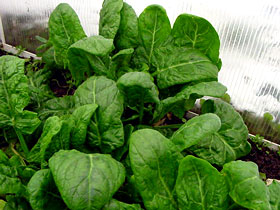
Gardeners are eager to get out in the garden this time of year, and on the first warm spring day you'll see people out planting. But in most regions, it's just too early unless you're able to protect tender plants during the next cold snap. One way to protect them is with a cold frame or small greenhouse.
Many parts of the country are experiencing erratic weather — cold and snowy one week, warm and sunny the next. Changeable weather like this is hard on plants because the warmth stimulates growth that then gets nipped by the next round of cold. Established plants that are hardy to your region should be fine — they're adapted to the conditions and will recover. But new plants and those that aren't hardy need protection, and cold frames fit the bill.
What is a Cold Frame?
Essentially, a cold frame is a miniature greenhouse that protects plants from chilling winds and low temperatures. Some cold frames are constructed of plastic or nylon sheeting held aloft with wire hoops or wooden frames; others are made from rigid polycarbonate. As the sun passes through the clear or translucent covering, it warms the air and ground inside the cold frame. Some of this warmth is retained overnight when the outside temperature drops.
Prevent Frost Damage and Sunburn
The most obvious protection a cold frame can provide is from frost, since the inside stays warmer than the surrounding air. Frost damage results in blackened leaves, especially on the uppermost parts of the plant, and can kill susceptible plants so it's vital to protect them. But did you know that plants can also get sunburn? Houseplants or seedlings that have spent time indoors will have adapted to low light levels, modifying their leaves so they can gather the light they need. Bringing the plants outdoors into the bright sun will likely result in a bad case of sunburn in as little as a few hours. Sunburned leaves looked bleached and sickly; a badly burned plant may not recover. A cold frame is a perfect place to help indoor plants make the transition to outdoor conditions, a process called hardening off.
Hardening Off Plants
Seedlings you've grown yourself and those grown in commercial greenhouses will need a period of hardening off to acclimate them to harsher outdoor conditions. Placing the seedlings in a cold frame and exposing them to increasing amounts of sun, cool temperatures, and wind over the course of a week or two will help them adapt. You can drape a shade cloth over the cold frame to provide light shade early in the process. The same goes for houseplants that you bring outdoors during the summer — placing them in a cold frame for a few weeks can help them adapt. Most houseplants are native to tropical regions and will suffer if temperatures drop below 50F.
Plant a Few Weeks Early
By placing a cold frame directly over a garden bed, you can plant seeds or set out transplants a few weeks before your usual planting time. In many regions, gardeners can grow cold-hardy greens, such as spinach, all winter long under their cold frames. Once the weather heats up, you'll need to remove the cold frame; otherwise, the sun will heat it up too much. In fall, replace the cold frame and enjoy greens and other cool-season vegetables right into winter.
Step Up to a Greenhouse
Cold frames are handy, but there's nothing like a freestanding greenhouse when it comes to getting a jump on the gardening season. Not only does a greenhouse offer more room, it also allows you to stand up while you tend your plants. You might be surprised at how affordable a portable greenhouse is.